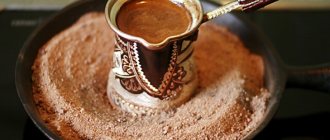How did Vietnamese coffee come about?
With the introduction of coffee culture to Vietnam by French missionaries in 1857, a new era for the country began. Coffee is tightly and deeply woven into the social and economic spheres of modern Vietnam. Currently, Vietnam ranks confidently in second place after Brazil in terms of coffee export volumes. The country, which previously did not know about coffee, made it its national drink in a fairly short period.
Vietnamese coffee, combining favorable climatic conditions coupled with fertile soils, French roasting, and introducing a bit of traditional Vietnamese originality, has conquered not only the Vietnamese themselves, but also the coffee world.
The Vietnamese, before the advent of coffee trees, preferred tea. And with the advent of coffee, the leaves of coffee trees were first brewed. And later they noticed the invigorating effect of coffee berries, learned to roast them and, at first, just hold them in their mouth. Later, the culture came to grind beans and prepare Vietnamese coffee following the example of the French.
Vietnamese coffee is prepared using the filtered method using traditional fins (press filters) for brewing coffee, the ancestors of which are disposable French filters.
Vietnamese coffee is famous for its variety of flavors and richness. And what distinguishes it from more European coffee is that the taste of Vietnamese coffee is unforgettable!
Vietnamese coffee
Ingredients:
- Two teaspoons of ground grains;
- Special filter;
- One hundred milliliters of water.
Cooking method:
- First, you should disassemble all parts of the filter into their components and wipe them.
- Place the container and stand on the cup.
- Pour the grains into the container, then take the press and twist the handle several times in a clockwise direction.
- Now add a little boiling water to the grains.
- After a few seconds, pour in the remaining water.
- Close the lid and wait for the coffee to start dripping.
- If the drink drips very slowly, it means the grains have been compacted tightly.
- But if, on the contrary, it flows quickly, then it was poorly compressed.
- You can regulate this process yourself by pressing the press or loosening it.
- Proper brewing is considered to be when fifty drops of coffee fall into the cup in one minute.
- One serving of Vietnamese coffee should take about five minutes to prepare.
- After which you can try the aromatic Vietnamese drink.
- For this recipe, the grains should be medium ground.
Enjoy your coffee!
Where does condensed milk come from in Vietnamese coffee?
There are at least three theories about the appearance of condensed milk in Vietnamese coffee:
1. French - The French, who brought coffee culture with them to Vietnam, found that obtaining and storing fresh milk, especially with intermittent or complete lack of electrification in some areas, was difficult to live with. In this sense, canned condensed milk completely solved the problem. For French paradise, all that remained was to teach the Vietnamese how to cook baguettes and croissants. Today, the famous coffee capital - the city of Dalat in Vietnam - is a small Europe. It is distinguished by both the French style of construction and French delicacies - desserts, crispy baguettes, and even French frog legs =)
By the way, the French brought to Vietnam not only coffee, but also a drip press filter - a fin for brewing coffee. You can learn about the benefits of filtered coffee in the article “Filtered Coffee.”
2. Russian - According to one version, the USSR supplied humanitarian aid to Vietnam with condensed milk, which the Vietnamese fell in love with and became a successful tandem with traditionally dark French roast coffee.
3. American - According to another version, condensed milk appeared among the Vietnamese during the period of US military expansion. The Vietnamese tried condensed milk from the rations of captured American soldiers and liked it.
Be that as it may, one thing is certain - Vietnamese strong coffee goes well with condensed milk. Sweet condensed milk adds smoothness and creaminess to rich Vietnamese coffee. This coffee in Hanoi is the best quick breakfast, complemented only by a steamed rice bun.
Hot strong coffee in Vietnamese style
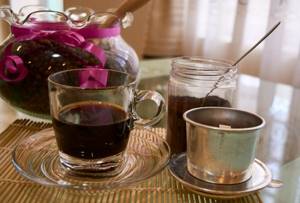
Ingredients:
- Glass glass, mug.
- Boiling water – 100 ml
- Special metal filter
Cooking method:
- You will need to disassemble a special filter press into its component parts; lid, press, container, stand.
- Place the container and stand on a glass glass or mug.
- Depending on your preferred strength, pour 2-3 teaspoons of medium-ground coffee into the container and distribute the coffee evenly over the bottom of the filter container.
- Place the press on the container and lightly compact the coffee by twisting the press handle.
- Boil the water.
- Next, pour 10-15 ml of boiling water into the container with coffee, let it brew for 30 seconds.
- Add 80-75 ml. boiling water, the filter handle should not be completely filled with water, cover it with a lid.
- The perfect Vietnamese coffee takes about 5 minutes to brew.
- You can adjust this process by pressing or loosening the press while preparing this drink.
- Pay attention to the benefits
- Your coffee will not “run away” onto the stove, there is no bitterness that is not typical for real coffee, the speed of preparation is that does not require your constant attention.
Enjoy your coffee!
What condensed milk is suitable for Vietnamese coffee?
In Vietnam, condensed milk of plant origin is more common. Typically coconut. It is important to note that such condensed milk does not have the cloying smell of coconut and is practically indistinguishable in taste from condensed milk made from whole milk of animal origin.
Condensed milk with animal cream became widespread in Vietnam during the period of development of trade relations with the USSR. They say that the Vietnamese fell in love with GOST condensed milk, but it is extremely rare on the shelves of ordinary supermarkets.
In addition to canned condensed milk, dry coconut cream is widely used in cooking in Vietnam. You can quickly make improvised condensed milk from them by dissolving dry vegetable cream in a small amount of water.
Benefits of Condensed Milk from Dry Coconut Cream
:
- Low calorie content - coconut cream itself is quite sweet due to the natural sugars it contains; additional sugar should only be added to those with an avid sweet tooth;
- Vietnamese coffee with condensed milk from coconut cream is the same coffee with milk for weight loss;
- Does not require storage in the refrigerator - dry coconut cream can be stored at room temperature without loss of taste and quality properties;
- Suitable for people with intolerance to cow's milk protein and animal products.
Besides all that, dry coconut cream is simply delicious!
Vietnamese egg coffee
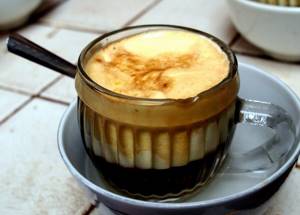
Ingredients:
- black coffee - small cup
- condensed milk - 2 teaspoons
- egg yolk - 1
Cooking method:
- Brew coffee using the method you prefer.
- Beat the yolk with condensed milk and one spoon of coffee until foam forms.
- Pour the resulting mixture into black coffee.
- Add sugar or other sweetener if desired.
Enjoy your coffee!
Benefits of brewing coffee in Finland
Why do Vietnamese people prefer to brew coffee using the drip method using a traditional coffee fin? This method has a number of undoubted advantages:
- Allows you to brew any coffee, including those prepared in a traditional or original way, caramelized, with specific natural additives;
- Does not require electricity;
- Coffee prepared in Fin is richer and more aromatic;
- Filter coffee is healthier;
- Brewing in a fin is also a meditative process, in which you can immerse yourself while watching the process of preparing coffee, slowly dripping into a glass.
Vietnamese egg coffee

Ingredients:
- 1 cup of freshly brewed coffee;
- 1 egg;
- 2 teaspoons condensed milk.
Cooking method:
- First of all, brew 1 serving of coffee.
- Then, separate the yolk from the white.
- Whisk the yolk thoroughly with condensed milk and add to a cup of coffee.
- While the yolk is spreading over the coffee, whip the white into a thick foam and place it on top of the coffee.
- The most delicate Vietnamese coffee with egg is ready.
Enjoy your coffee!
What kind of coffee is suitable for cooking in Finland?
To prepare coffee in Finland, you should give preference to medium-ground coffee. Finely ground coffee is more suitable for cooking in a Turk, and it can simply clog the perforated filter. If you use coarsely ground coffee to make coffee in Finland, the taste will be less intense and the drink will be less aromatic. But this option is liked by those who prefer more European tastes of coffee and a lower density of the drink.
Vietnamese iced coffee

True connoisseurs of the drink know how to prepare iced coffee to surprise guests and treat themselves to something delicious. For such cases, a Vietnamese iced coffee recipe will come in handy. Its peculiarity is the addition of tapioca balls to the drink.
Ingredients:
- 30 g coffee;
- 100 gr. tapioca balls;
- crushed ice;
- 620 ml water;
- 125 ml milk;
- 2 teaspoons sugar.
Cooking method:
- Tapioca balls are placed in boiling water and cooked for 10 minutes.
- Rinse the finished balls in cold water and leave them to cool.
- Brew strong espresso.
- Condensed milk and, if necessary, sugar are added.
- Place the drink in the refrigerator.
- Place tapioca at the bottom of the glass and add crushed ice.
- Pour coffee into the drink and garnish with cream.
Enjoy your coffee!
Vietnamese coffee options
Many people think that Vietnamese coffee is exclusively hot coffee with condensed milk. This is not entirely true. Vietnamese coffee has variations in preparation depending on the region and taste preferences.
Step-by-step recipe for making Vietnamese coffee (cà phê đen - black coffee)
Despite the strength and rich taste of Vietnamese coffee, it has many adherents in its pure form - without additives.
Vietnamese coffee is always prepared using the traditional drip method using a coffee fin, which is a cup with a perforated bottom and a press installed inside. This filter is simply placed on a cup or glass, from which you can then drink freshly prepared coffee. Although it is customary for the Vietnamese to prepare coffee in large portions at once for the whole day.
Vietnamese coffee varieties
The most popular types of coffee beans in Vietnam are Arabica and Robusta. Their varieties are sold both in pure form and mixed with each other in various proportions. But Luwak, extracted from animal excrement, is an attraction for tourists. The drink made from beans of this variety, offered at tastings, does not differ in taste from ordinary Robusta, and its “special” taste properties are caused by self-hypnosis. If you want to try real elite coffee, pay attention to excelsa - the rarest type that is part of exquisite varieties. When tasting coffee in Vietnam, trust not advertising, but your own taste sensations. Buy the varieties that you really like. And let your morning begin with the most delicious coffee in the world!
Previous
CuisineSeafood restaurants in Nha Trang: where to eat fish and seafood
Next
CuisineWhere to buy seafood in Nha Trang
The basic step-by-step recipe for making Vietnamese coffee is quite simple.
Ingredients and tools for Vietnamese coffee:
- Vietnamese medium ground coffee
- Hot water (92-950C)
- Traditional Vietnamese fin (French filter)
- Favorite cup
Before cooking, rinse the cup and fin with boiling water to warm up.
Step 1: Use boiling water to rinse the coffee filter and rinse the cup to reduce heat absorption by the utensil when brewing coffee. This way, the coffee will expand evenly and impart flavor and aroma to the drink.
Step 2: Pour 3 teaspoons of ground coffee (about 25 grams) into the filter and spread evenly over the surface of the filter.
Step 3: Place an internal press into the fin (screw or press with a regular perforated one - depending on the model of the fin). It is important to press the coffee not too lightly (this will cause the water to pass through the coffee too quickly and it will turn out unsaturated) and not too hard (the coffee will take too long to cook). The optimal pressure is at which the liquid passes through the filter at a speed of 1-2 drops per second. After a couple of experiments, you will understand exactly what pressure is sufficient.
Step 4: Place the fin on the cup, slowly and evenly pour hot water (92-950C) over the surface of the internal filter pressing the coffee into the filter, filling it halfway. Cover with a lid. It is important to pour the coffee not with boiling water, but with slightly cooled water, otherwise the taste of the coffee will be dominated by sourness.
Step 5: After 5 minutes, open the lid of the fin and fill it completely with hot water, cover it again.
Step 6: In 5-10 minutes your Vietnamese coffee is ready! Enjoy!
The secret of tasty and rich Vietnamese coffee, according to the Vietnamese, lies in a pinch of salt, which should be added when preparing coffee. This simple and affordable ingredient will reveal new organoleptic facets of your favorite drink.
This step-by-step recipe is the basis for several types of Vietnamese coffee. In the traditions of Vietnam, Vietnamese coffee is prepared in three versions.
Vietnamese iced coffee (phê sữa đá)
Cold drinks are more common in the south of Vietnam. Vietnamese iced coffee
– an excellent solution for those who want to cool down, cheer up well and quickly fight hunger. It is also called Saigon coffee (ca phe sua da - Vietnamese Iced Coffee) - Vietnamese iced coffee.
To make Vietnamese iced coffee you will need a basic step-by-step Vietnamese coffee recipe, only you must first add 3 tablespoons of condensed milk to the glass and add a few ice cubes when ready.
It is known that the Vietnamese prepare large volumes of coffee at once for the whole day and to prepare cold Vietnamese coffee, pour condensed milk and ice into a glass of ready-made chilled Vietnamese coffee. This method is good for saving time, but it excludes the aesthetic pleasure of watching the fascinating process of making Vietnamese coffee. It is so beautiful if you place the coffee fin on a transparent glass! Gourmets note that cold Vietnamese coffee has a richer taste.
Vietnamese iced coffee is so famous that high-profile foreign visitors to Vietnam are looking for places to try it. Once, while visiting Saigon, the Prime Minister of Canada wanted to try Vietnamese coffee.
It is also known that during a trip to Hanoi, former US President Barack Obama could not forget to mention Vietnamese iced coffee. This is not surprising because the way Vietnamese iced coffee is made has been recognized by Bloomberg as one of the 10 most unique coffee dishes in the world. In addition, CN Traveler Magazine also named this drink as the first can't-miss drink if visitors have the chance to visit Vietnam.
Vietnamese coffee
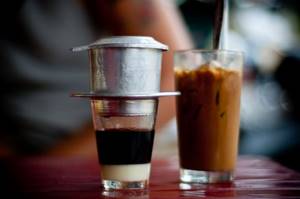
Ingredients:
- Vietnamese ground coffee - 2-3 teaspoons;
- Cool boiling water – 90-100ml;
- Special metal filter;
- Mug or glass.
Cooking method:
- Disassemble the press filter into its component parts: stand, container, press and lid.
- Wipe all elements with a clean cloth.
- Place the container and stand on a heat-resistant glass or cup.
- Pour two or three teaspoons of ground coffee into the container.
- You can, if desired, change the amount of ground coffee depending on the richness of the taste you prefer.
- Distribute the ground coffee evenly across the bottom of the filter.
- To do this, you can slightly tilt it in different directions or shake it.
- Medium grind coffee is recommended.
- We take a press - this is a strainer with a handle and tamp the coffee, lightly turning the press by the handle several times clockwise, although you can do it counterclockwise, there will be no difference in taste.
- We don’t put any special effort into this.
- Boil water.
- Next, we give the coffee its first chance to demonstrate its aroma and pour 10 ml of boiling water into the container.
- We wait no more than 15-20 seconds.
- The coffee begins to “work”, steam, and we add the remaining boiling water - 80 ml, so that the handle of the press is not completely covered with water.
- Cover the container with a lid.
- We are waiting for the moment when the coffee starts to drip.
- It is important to know that if coffee drops run out of the coffee filter very quickly, then we have not compacted the coffee tightly enough.
- If the coffee brews slowly, then we have pressed it too hard.
- This can be corrected even during the brewing process by pressing or loosening the press.
- You need to adjust it so that the coffee drips into the cup or glass at a speed of 45-50 drops per minute.
- The skill will come with time.
- You need to know that the perfect cup of Vietnamese coffee takes about five minutes to brew. Well, five minutes have passed.
- Remove the press filter and place it on the inverted lid. You can enjoy hot black coffee the Vietnamese way.
- We drink in small sips, savoring the tart taste.
Enjoy your coffee!
Vietnamese coffee: good or bad?
Although coffee lovers are quite snobbish about Robusta, preferring the usual Arabica, Vietnamese producers are quite successfully fighting stereotypes about its bitterness and unpleasant earthy taste. Local coffee has a neutral taste with notes of bread, cocoa and chocolate, and here's why:
- Ripe Robusta berries do not immediately fall off the branch (unlike Arabica). This allows you to harvest at one time when 90-95 percent of the berries are ripe, and the fruits are at approximately the same degree of sweetness.
- On large farms, coffee is processed using the semi-washed method (aka “hani”), when only part of the pulp is removed from the beans, and the remaining gluten gives sweetness to the grain during the drying process.
Vietnamese robusta is not as dense and rich in taste as African robusta. But many manufacturers use special methods of processing grain, in which Robusta turns out to be more neutral in taste, without its characteristic harsh woody-earthy tones.

All this applies to grain going for export. Ordinary Vietnamese drink the most inexpensive coffee, which differs in quality for the worse. Hence the difference in opinions: some try good quality robusta, designed for foreigners, while others are unlucky, and a negative impression of local coffee is formed thanks to drinks with condensed milk and ice from roadside cafes.
Ground coffee Lebo “Prince”, for Turkish, 100 g 79 rub.
Coffee beans LavAzza “Qualita Oro”, 500 g 752 rub.
Ground coffee Lavazza “Crema e Gusto”, 250 g 258 rub.
Lavazza “Qualita Oro” coffee beans, 250 g 351 rub.
Ground coffee Lebo “Extra”, for Turkish, 75 g 61 rub.
Ground coffee Lavazza “Qualita Oro”, in a tin can, 250 g 400 rub.
Bean coffee Bushido “Red Katana”, 1000 g 1921 rub.
Coffee beans Lavazza “Qualita Oro”, 1000 g 1550 rub.
Even more coffee on TEA.RU
Vietnamese coffee with condensed milk
Coffee appeared in Vietnam during the French occupation. At that time, France united three countries: Cambodia, Laos and Vietnam under the common name French Indochina.
Therefore, it is more correct to call coffee not Vietnamese, but “Indochina coffee.” It was the French who taught the Vietnamese to grow Arabica and Robusta coffee trees.
There are a large number of coffee plantations in Vietnam, so the choice of fresh coffee is huge. It is sold in beans and ground, with or without flavorings.
The main Arabica production area in Vietnam is the Thái Nguyên region, a city in the northeastern part of Vietnam. The administrative center of Thai Nguyen Province, which includes the provinces of Kon Tum, Gya Lai, Dak Lak, Dak Nong and Lam Dong. Coffee here is grown at an altitude of 1200 to 1600 meters above sea level. The main variety grown is catimor, in whose genes there is a relationship with robusta, which explains the rather dense and unusual taste for Arabica.
Sweet and strong coffee with the addition of condensed milk, ice and even eggs, this is how they drink it in Vietnam. Many travelers would like to cook it at home. It's very simple!
To prepare this aromatic drink, you will need a Vietnamese Phin, a coffee brewing device. It can be aluminum, stainless steel, silver or ceramic.
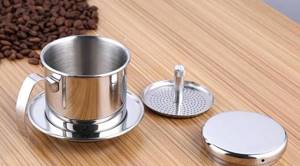
“Fin” consists of four parts:
- Filter element, it is placed in a clean mug.
- The flask where the coffee is poured, the grind should be medium, as for filter coffee.
- A press with which you need to press down dry coffee before pouring hot water.
- Lid to close the fin.
Step by step recipe:
- Take a glass glass or mug, pour a portion of condensed milk into it, and for a refreshing “Ice coffee” add another 3-4 ice cubes.
- Place 2-3 tablespoons of medium or coarse ground coffee into the fin (coffee filter), distributing it evenly over the bottom. The amount of coffee affects the strength of the drink; if you want it thick like the Vietnamese, then add 3-4 spoons, or even more.
- Cover the coffee with a press (a strainer with a handle), compact it lightly, twisting it a couple of times, no need to press.
- First pour a little boiling water so that the coffee absorbs this moisture, let it “bloom” for 30-40 seconds, and only then pour hot water over the coffee and cover with a lid.
- The finished coffee should slowly drip into the mug through the holes in the press, which is why you tamped the coffee.
- Next, the Vietnamese add ice (yes, that’s ice) in hot climates it’s very tasty,
Vietnamese coffee
Number of votes: 21 2
5
1
21
Was the information helpful? Rate and leave a comment? Better yet, share!
Comments
We will be glad if you share your opinion or add to a note or article.
